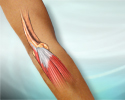Tennis elbow surgery
Lateral epicondylitis - surgery; Lateral tendinosis - surgery; Lateral tennis elbow - surgery
Tennis elbow is caused by doing the same repetitive and forceful arm movements many times. It creates small, painful tears in the tendons in your elbow.
This injury can be caused by tennis, other racquet sports, and activities such as turning a wrench, prolonged typing, or chopping with a knife. The outside (lateral) elbow tendons are most commonly injured. The inside (medial) and backside (posterior) tendons can also be affected, but usually with different activities. The condition can be worsened if the tendons are further injured by trauma to the tendons.
This article discusses surgery to repair tennis elbow.
Description
Surgery to repair tennis elbow is often an outpatient surgery. This means you will not stay in the hospital overnight.
You will be given medicine (sedative) to help you relax and make you sleepy. Numbing medicine (anesthesia) is given in your arm. This blocks pain during your surgery.
You may be awake or asleep with general anesthesia during the surgery.
If you have open surgery, your surgeon will make one cut (incision) over your injured tendon. The unhealthy part of the tendon is scraped away. The surgeon may repair the tendon using something called a suture anchor. Or, it may be stitched to other tendons. When the surgery is over, the cut is closed with stitches.
Sometimes, tennis elbow surgery is done using an arthroscope. This is a thin tube with a tiny camera and light on the end. Before surgery, you will get the same medicines as in open surgery to make you relax and to block pain.
The surgeon makes 1 or 2 small cuts, and inserts the scope. The scope is attached to a video monitor. This helps your surgeon see inside the elbow area. The surgeon scrapes away the unhealthy part of the tendon.
Why the Procedure Is Performed
You may need to have surgery if you:
- Have tried other treatments for at least 3 months
- Are having pain that limits your activity
Treatments you should try first include:
- Limiting activity or sports to rest your arm.
- Changing your sports equipment you are using. This may involve changing the grip size of your racket or the weights that you use.
- Changing the types of tools that you are using that cause discomfort.
- Changing your sports practice schedule or duration.
- Taking medicines, such as aspirin, ibuprofen, or naproxen.
- Doing exercises to relieve pain as recommended by the doctor or physical therapist.
- Making workplace changes to improve your sitting position and how you use equipment at work.
- Wearing elbow splints or braces to rest your muscles and tendons.
- Getting shots of steroid medicine, such as cortisone. This is done by your health care provider.
Risks
Risks of anesthesia and surgery in general are:
- Reactions to medicines or breathing problems
- Bleeding, blood clots, or infection
Risks of tennis elbow surgery are:
- Loss of strength in your forearm
- Decreased range of motion in your elbow
- Need for long-term physical therapy
- Injury to nerves or blood vessels
- Scar that is sore when you touch it
- Need for more surgery
Before the Procedure
You should:
- Tell the surgeon about all the medicines you take, including those bought without a prescription. This includes herbs, supplements, and vitamins.
- Follow instructions about temporarily stopping blood thinners. These include aspirin, ibuprofen, (Advil, Motrin), and naproxen (Naprosyn, Aleve). If you are taking warfarin (Coumadin), dabigatran (Pradaxa), apixaban (Eliquis), rivaroxaban (Xarelto), or clopidogrel (Plavix), talk with your surgeon before stopping or changing how you take these drugs.
- Ask your surgeon which medicines you should still take on the day of your surgery.
- Stop smoking, if you smoke. Smoking can slow healing. Ask your health care provider for help.
- Tell your surgeon if you have a cold, flu, fever, or other sickness before your surgery.
- Follow instructions about not eating or drinking anything before surgery.
- Arrive at the surgery center when your surgeon or nurse told you to. Be sure to arrive on time.
After the Procedure
After the surgery:
- Your elbow and arm will likely have a thick bandage or a splint.
- You can go home when effects of the sedative wear off.
- Follow instructions on how to care for your wound and arm at home. This includes taking medicine to ease pain from the surgery.
- You should begin moving your arm gently, as recommended by your surgeon.
Outlook (Prognosis)
Tennis elbow surgery relieves pain for most people. Many people are able to return to sports and other activities that use the elbow within 4 to 6 months. Keeping up with recommended exercise helps ensure the problem will not return.
References
Adams JE, Steinmann SP. Elbow tendinopathies and tendon ruptures. In: Wolfe SW, Pederson WC, Kozin SH, Cohen MS, eds. Green's Operative Hand Surgery. 8th ed. Philadelphia, PA: Elsevier; 2022:chap 25.
Wolf JM. Elbow tendinopathies and bursitis. In: Miller MD, Thompson SR, eds. DeLee, Drez, & Miller's Orthopaedic Sports Medicine. 5th ed. Philadelphia, PA: Elsevier; 2020:chap 61.
Review Date: 12/12/2022
Reviewed By: C. Benjamin Ma, MD, Professor, Chief, Sports Medicine and Shoulder Service, UCSF Department of Orthopaedic Surgery, San Francisco, CA. Also reviewed by David C. Dugdale, MD, Medical Director, Brenda Conaway, Editorial Director, and the A.D.A.M. Editorial team.


